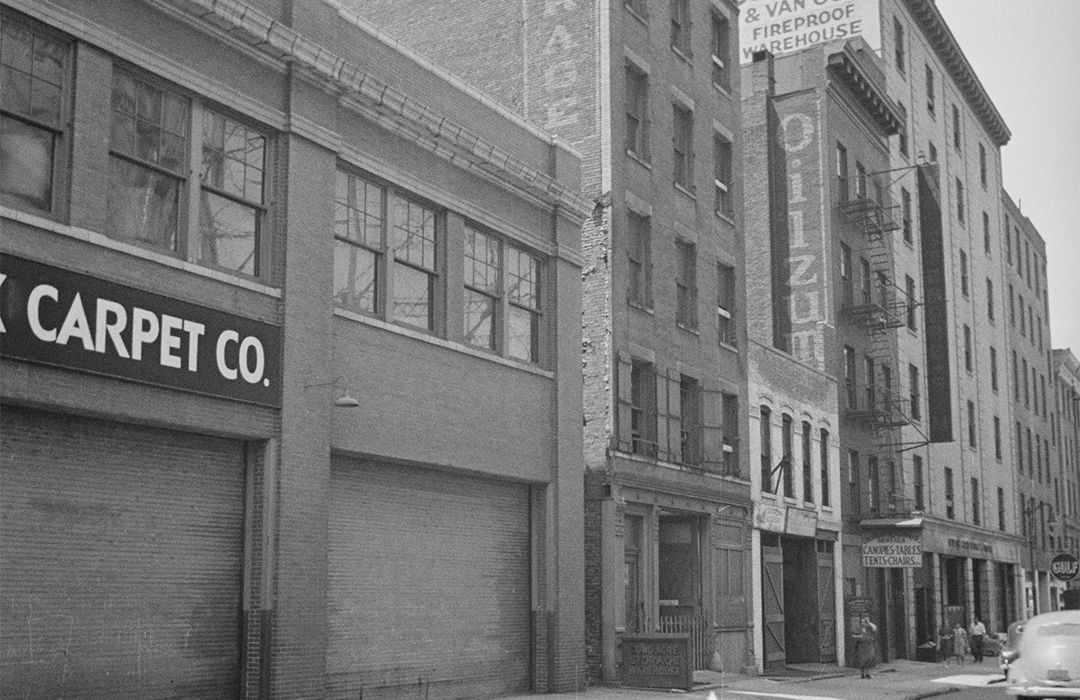
242 West 65th Street
by Tom Miller
Following the death of his father, in 1890 George W. Prodgers took control of the construction firm Wm. Prodgers & Son, “an old-established firm of New York, the character of whose work has always been of the best quality,” according to the Record & Guide that year. In 1898, Prodgers and his wife Caroline acquired the plot at 242 West 65th Street and commenced erecting a warehouse and stable.
Completed early in 1899, the utilitarian building was faced in brick above the ground floor. Ornamentation was reserved for the ambitious neo-Grec cornice that sprouted a tall flagpole. At street level, cast iron pilasters upheld a rosette-decorated entablature. Here, a two-doored carriage bay was flanked by a passenger doorway and a wooden-shuttered window. The Prodgerses almost assuredly were directed in the design of the building by Henry Adams. It appears he was the intended buyer before the ground was broken.
The upper floors were for storage of clients’ furniture and personal items.
On March 21, 1899, Henry Adams purchased 242 West 65th Street from William and Caroline Prodgers, paying cash for the entire amount. He immediately transferred the title to his adult daughter, Sarah Adams.
Henry operated what today would be known as a moving and storage business. The cellar and basement were licensed as a “stable” by the city, although the horses and vehicles were used for transporting household goods for people moving from one home to another. The upper floors were for storage of clients’ furniture and personal items. Henry managed the moving and storage portion of the business, while Sarah managed the rental of the upper floor spaces.
As motorized trucks became reliable, Henry Adams was quick to transition from horses to machines. An advertisement in The New York Times on May 12, 1912, noted, “Automobile vans to hire for long distance removal of household goods. Henry Adams Storage Warehouse, 242 West 65th.” The business was far-reaching. A decade later, an advertisement in the Trow Alcom Blue Book outlined the extent of his operation:
Auto Vans for Local and Long Distance Moving
Furniture Boxed, Packed and Shipped to All Parts of the World
Packers—Shippers—Movers—Storage Warehouse
On March 22, 1926, the New York Evening Post reported that Sarah Adams had leased the structure for five years. The article noted, “This building was formerly occupied by the Adams Storage Warehouse people, who built it for their business in 1899.”
A pedestrian noticed fire coming from the building around 7:05 a.m.
By the early 1940s, the Avrick Paper Co., owned by Irwin A. Avrick occupied the building. The five floors of flammable paper and cardboard proved disastrous on May 6, 1950. A pedestrian noticed fire coming from the building around 7:05 a.m. By the time firefighters arrived, it had spread throughout the structure and soon traveled to another five-story building. The five-alarm blaze “finally caused the collapse of a two-story building under a falling wall,” reported The New York Times. Firefighters battled the inferno for two-and-a-half hours, during which three firemen were injured. Assistant Fire Marshall John Sullivan later revealed “that it apparently had been burning from eight to ten hours” before the passerby noticed the fire.
Following the inferno there was little left Henry Adams’s 1899 building. The following year, the Department of Buildings described a “single-story fender, body and motor vehicle repair shop” on the site. That structure survived until 1974, when the block was razed to make was for the Amsterdam Houses Annex.
Tom Miller is a social historian and blogger at daytoninmanhattan.blogspot.com


